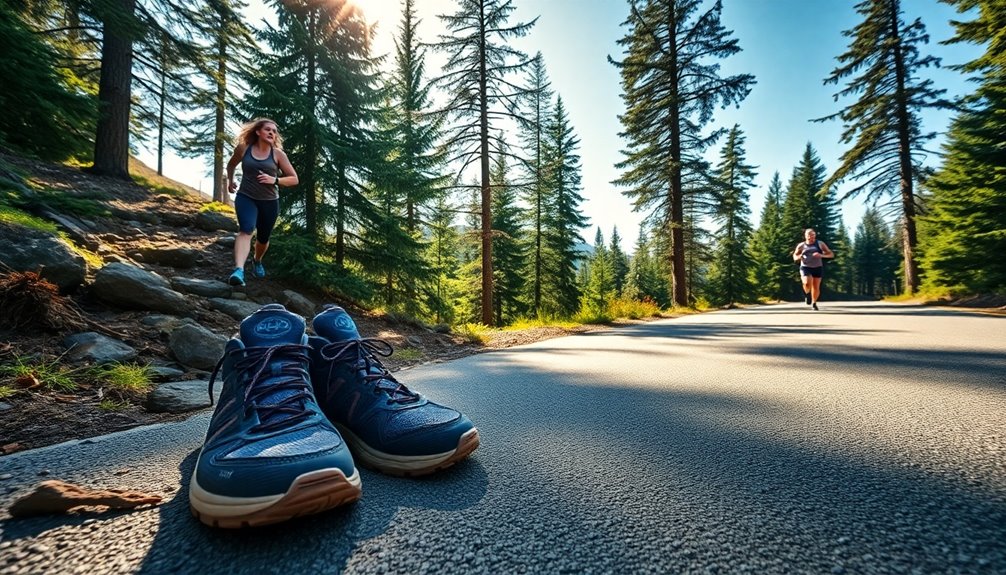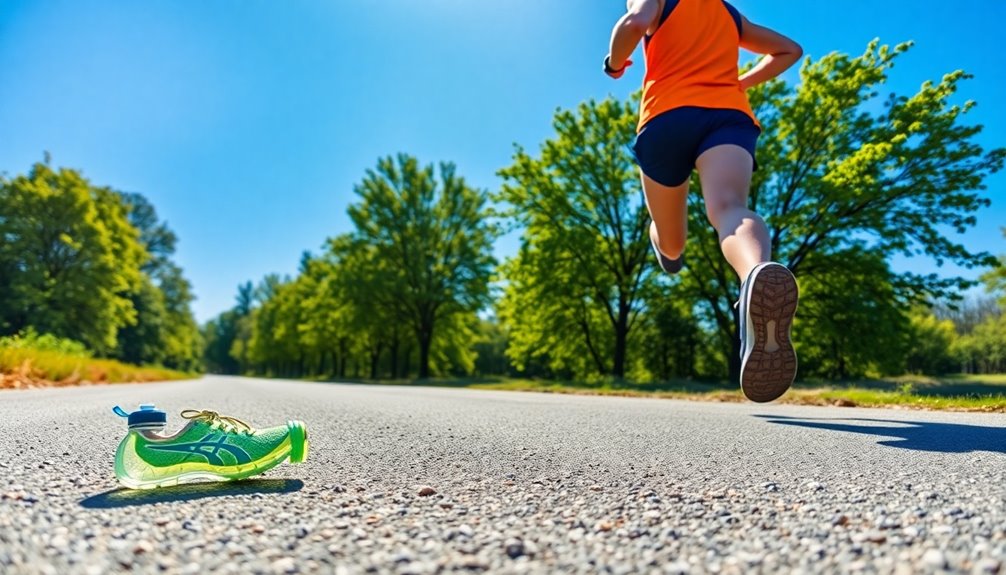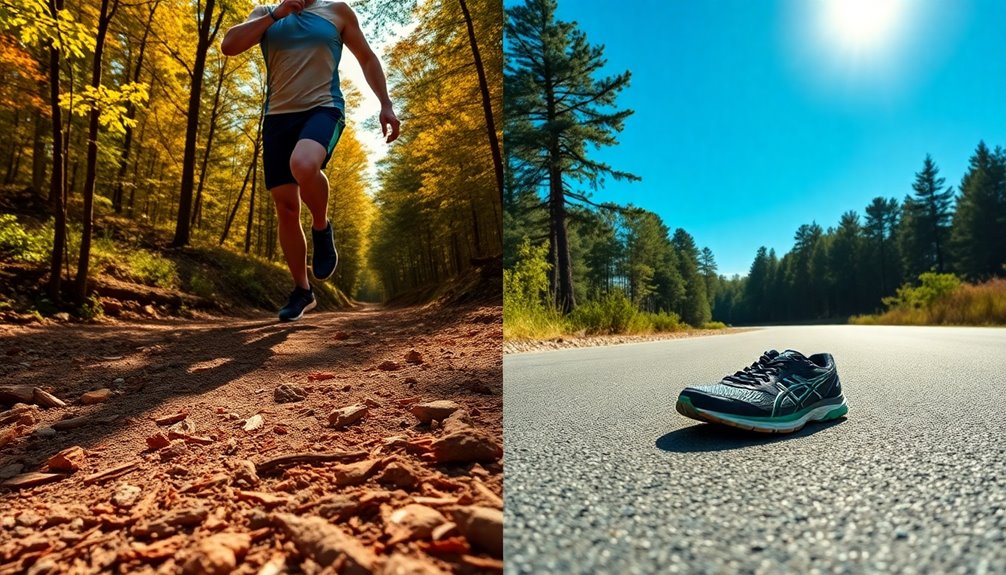If you’re torn between trail running and road running, consider your goals. Trail running immerses you in nature and builds strength, but it exposes you to uneven terrain and unique injuries. Road running offers speed and consistency on flat surfaces, but it can lead to overuse injuries and lacks scenic variety. Think about your preferences and environment. There’s a lot more to explore to find the running style that fits you best. Researching different running techniques for beginners can also help you decide which style suits you better. Trail running may require you to develop skills in navigating obstacles and adapting your pace, while road running focuses more on steady endurance and rhythm. Ultimately, the best choice is one that aligns with your fitness goals and keeps you motivated to hit the trails or roads consistently.
Key Takeaways
- Consider trail running for a more immersive nature experience, enhancing mindfulness and mental well-being while burning more calories.
- Choose road running if you prefer speed and consistency on smooth surfaces, making it easier to track pace and mileage.
- Evaluate injury risks; trail running presents unique challenges like uneven terrain, while road running may lead to repetitive strain injuries.
- Assess your environment; trail running requires navigation skills and weather readiness, whereas road running can involve traffic safety concerns.
- Select appropriate footwear based on your choice; trail shoes offer traction on rugged paths, while road shoes provide cushioning for flat surfaces.
Understanding Trail Running

Trail running immerses you in nature, offering a rejuvenating escape from the monotony of paved roads.
Unlike road running, it challenges you with uneven terrain and technical trails that demand greater focus and awareness. You'll need specialized trail running shoes that provide deep lugs for ideal traction on trails, ensuring you stay stable on rocky paths and dirt trails.
This sport also promotes strength and balance, as maneuvering obstacles requires powerful muscles and coordination. Plus, running on varied surfaces can reduce the impact on joints compared to hard pavement. Engaging in this form of exercise also supports emotional regulation, helping you manage stress and improve your overall well-being.
Embrace the beauty of natural environments while honing your skills and building greater strength, making each run not just a workout but an adventure in the great outdoors.
Benefits of Trail Running

Running on trails offers a multitude of benefits that can enhance both your physical and mental well-being. Trail running, with its uneven terrain, challenges you to burn more calories and build strength while minimizing the impact on your joints. The soft surfaces reduce injury risk and promote quicker recovery. Engaging different muscle groups improves endurance and balance.
Additionally, the focus required for maneuvering around obstacles fosters mindfulness, allowing you to connect with nature and reduce stress. Plus, you'll enjoy scenic views that uplift your mental well-being compared to urban settings. Many trail runners also appreciate the experience of unique culinary experiences, which can enhance their outdoor adventures.
| Benefit | Description | Impact on You |
|---|---|---|
| Burns More Calories | Increased effort on uneven terrain | Weight management |
| Lower Impact | Soft surfaces reduce joint stress | Quicker recovery |
| Builds Strength | Engages diverse muscle groups | Improved endurance |
| Enhances Mindfulness | Focus on nature during runs | Stress reduction |
| Scenic Views | Beautiful natural settings | Boosts mental well-being |
Challenges of Trail Running

When you hit the trails, you face unique challenges that can test your skills and adaptability.
From the risk of injury due to uneven surfaces to the need for navigation and weather readiness, trail running demands your full attention. Quality Assurance practices can also be applied to prepare for potential hazards and improve your overall experience.
Understanding these challenges can help you prepare and enjoy the experience more safely.
Injury Risks and Prevention
Guiding through the rugged terrain of trails can pose unique injury risks that every trail runner should be aware of. The uneven terrain increases the likelihood of ankle sprains and falls, while acute injuries can occur from missteps. To mitigate these risks, consider the following strategies:
| Strategy | Benefits | Recommendations |
|---|---|---|
| Use trail running shoes | Enhanced grip and protection | Look for reinforced uppers |
| Wear protective gear | Cuts and scrapes prevention | Arm and leg protection |
| Focus on strength training | Improved stability | Target ankles, calves, and core |
| Stay alert | Reduce acute injuries | Maintain constant attention |
| Vary your routes | Adapt to different terrains | Explore a range of trails |
Additionally, using dry, seasoned wood in a wood stove can improve indoor air quality, which is essential for runners looking to maintain optimal respiratory health while training outdoors.
Navigation and Trail Familiarity
Trail running presents unique challenges, particularly when it comes to navigation and familiarity with the terrain. You'll encounter obstacles like roots, rocks, and steep inclines that require constant attention.
To enhance your experience and safety, consider these key points:
- Know the trails: Familiarity with your route helps you anticipate challenges.
- Use a map: Many trails aren't well-marked, so a physical map or GPS device is essential.
- Inform someone: Share your planned route and expected return time for safety.
Getting lost is a real risk, especially in remote areas where cell signals can be unreliable. Additionally, understanding how to navigate using natural landmarks can significantly improve your ability to maintain direction while on the trail.
Weather Adaptability Challenges
While enjoying the great outdoors, you're likely to face unpredictable weather conditions that can change in an instant. For trail runners, weather adaptability is vital as you navigate rapidly changing elements like sudden rain, wind, or temperature drops.
Unlike road running, uneven terrain can become slippery or muddy, increasing your risk of falls. Limited visibility during foggy or rainy conditions makes wearing bright, reflective gear important for safety.
Additionally, the absence of shelter in remote areas intensifies the challenges posed by adverse weather. To stay comfortable and safe, invest in lightweight waterproof jackets and familiarize yourself with local weather patterns. Understanding the physical effects of narcissistic abuse can also provide insight into how chronic stress from such situations might affect your performance.
Being prepared guarantees you can enjoy your trail runs, regardless of what Mother Nature throws your way.
Overview of Road Running

Road running offers a unique experience as you navigate smooth, flat, paved surfaces like roads and sidewalks. This environment provides a consistent running experience, but it also comes with considerations that every runner should know:
- Faster paces: You can achieve higher turnover and speed.
- Repetitive motion: The hard surfaces may lead to quicker muscle breakdown.
- Visibility: Running near traffic requires safety measures like reflective clothing.
While road running gives you the stability of a predictable setting, it increases your risk of overuse injuries due to the nature of the surface. Additionally, maintaining proper air quality during your runs can enhance your overall performance and health.
Be mindful of distractions from traffic, and always prioritize your safety while enjoying the exhilarating experience of road running.
Advantages of Road Running

If you're looking to improve your speed and performance, road running offers several advantages that make it an appealing choice.
The hard, consistent surface of roads allows you to maintain a faster pace and higher turnover, perfect for speed workouts and competitive races. You won't have to worry about tripping over uneven terrain, letting you focus solely on your running.
Plus, with numerous local events, road running fosters a vibrant community where you can meet fellow runners.
The predictability of road surfaces also makes it easy to track your pace and mileage, enhancing your training effectiveness.
Finally, the lack of distractions allows for mental disengagement, letting you enjoy your workouts without obstacles in your way. Additionally, incorporating stress management techniques into your training routine can enhance both your mental clarity and overall performance.
Disadvantages of Road Running

Despite its many benefits, road running comes with notable disadvantages that can impact your health and overall experience. Here are a few key concerns:
- Overuse injuries: The repetitive foot strikes on hard surfaces can lead to shin splints and knee pain.
- Safety concerns: Running near traffic exposes you to accidents and distractions that could be avoided on trails.
- Limited mental health benefits: The lack of scenic variety and natural surroundings may reduce the stress relief often gained from outdoor exercise.
While good road running shoes can help mitigate some risks, the harder terrain and repetitive motion can hinder your recovery and enjoyment. Additionally, establishing an emergency fund can provide financial stability that may encourage you to invest in better running gear or training programs.
Considering these factors is essential for making an informed choice about your running routine.
Essential Gear for Trail Running

When hitting the trails, having the right gear can make all the difference in your running experience.
First, invest in trail shoes with soft lugs to provide better traction on uneven surfaces, helping you stay stable and avoid slips.
Pair them with lightweight breathable clothing to keep comfortable as you navigate changing weather and terrain.
A hydration vest is essential for carrying water and essentials, especially since trails often lack water sources.
Don't forget a light waterproof jacket to shield yourself from unexpected rain.
Finally, a headlamp is critical for low-light conditions, ensuring your safety and visibility when running in wooded or hilly areas during dawn or dusk.
Additionally, consider using gravel bikes for cross-training and enhancing your endurance on varied terrains.
With the right gear, you're set for an enjoyable trail run!
Essential Gear for Road Running

To enhance your road running experience, having the right gear is essential for comfort and performance. Here are a few must-haves for running on paved roads:
- Road shoes with adequate cushioning to absorb impact and provide support.
- Moisture-wicking clothing to keep you dry and minimize chafing during longer runs.
- Reflective gear to guarantee visibility when running in low-light conditions.
Additionally, consider a lightweight running belt for hydration and energy gels, keeping you fueled without frequent stops.
A GPS watch can help you track your pace, distance, and overall performance, making it easier to set goals.
With the right gear, you'll enjoy your runs while staying safe and comfortable.
Choosing the Right Running Shoe

When you're picking out running shoes, think about the terrain you'll be tackling.
Trail shoes offer deeper lugs and extra protection for rugged paths, while road shoes focus on cushioning for smoother surfaces.
Choosing the right features can make all the difference in your comfort and performance.
Trail Shoe Features
Choosing the right trail shoe is vital for a successful run, especially since trail conditions can be unpredictable. When you're maneuvering uneven surfaces, you'd want shoes designed for traction and stability.
Here are a few key features to look for in trail shoes:
- Deeper lugs for better grip on rugged terrain
- Stiffer midsoles with rock plates for added protection
- Reinforced uppers to guard against debris and moisture
These features guarantee you get the protection and stability you need while maintaining comfort.
Remember, trail shoes prioritize durability over cushioning, making them essential for preventing discomfort and injury on challenging trails.
Road Shoe Considerations
Finding the right road shoe can greatly impact your running experience, especially since the right fit and features can enhance both comfort and performance.
Look for road shoes with flatter, smoother outsoles designed for traction and durability on paved surfaces. Prioritize cushioning, as softer midsoles absorb impact from hard surfaces, reducing stress on your joints.
Verify your shoes fit well, allowing for adequate toe movement and a snug heel to prevent blisters during longer runs. Consider your foot type when selecting support; stability shoes help with overpronation, while neutral shoes suit those with a neutral gait.
Frequently Asked Questions
What Is the 80/20 Rule for Trail Running?
The 80/20 rule for trail running means you should run 80% of your miles at an easy, conversational pace, while only 20% should be at a higher intensity.
This approach helps you navigate uneven terrain more effectively and build strength during challenging sections.
What Are the Disadvantages of Trail Running?
When you're maneuvering the rugged dance of trail running, you might stumble upon a few pitfalls.
Uneven terrain can trip you up, increasing the chance of falls or ankle injuries. If you're used to measuring speed, the technical nature can slow you down, complicating your pacing strategies.
Plus, finding well-maintained trails isn't always easy, and specialized gear can hit your wallet hard. Weather shifts might keep you on your toes, testing your adaptability.
Do You Burn More Calories, Trail Running or Road Running?
You burn more calories when you go trail running compared to road running. The uneven terrain and obstacles require more effort, leading to an estimated 10-15% increase in calories burned per mile.
Plus, the varied foot strikes and elevation changes engage more muscle groups. On average, you can burn around 600 calories per hour on the trails, while you'd burn about 480 calories on the road at a similar pace.
Is Trail Running Better for Your Knees Than Road Running?
Kicking off with knee care, you'll find that trail running's softer surfaces can be kinder to your joints compared to road running.
It reduces impact, helping to strengthen the muscles around your knees. While you navigate uneven terrain, you'll need to focus on balance, which can prevent other injuries.
Plus, runners shifting to trails often recover faster from knee issues, making it a potentially better choice for knee health overall.
Conclusion
So, which path will you choose? Whether it's the rugged, unpredictable trails or the smooth, familiar pavement, each option offers its own set of thrills and challenges. Picture yourself conquering a steep hill, the wind in your face, or sprinting down a quiet road as the sunset paints the sky. The decision isn't just about running—it's about the adventure that awaits you. Are you ready to take the leap and discover where your feet will lead you?








